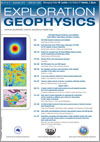
Exploration Geophysics
Volume 47 Number 4 2016
RESEARCH FRONT: 14th SAGA Biennial Conference and Exhibition
EG16014Joint inversions of two VTEM surveys using quasi-3D TDEM and 3D magnetic inversion algorithms
We present the results of a joint quasi-3D inversion of two VTEM datasets, flown over a VMS-Au prospect in northern Ontario, Canada, six years apart from one another. The TDEM data were inverted jointly using the spatially constrained inversion (SCI) approach and verified against known geology.
EG16015Airborne IP: examples from the Mount Milligan deposit, Canada, and the Amakinskaya kimberlite pipe, Russia
There has been evidence of the IP effect in TDEM data. This phenomenon is known to be responsible for incorrect inversion modelling of electrical resistivity, lower DOI and lost information about chargeability. In the current paper, we show the possibility of extracting IP information from VTEM data using Cole-Cole modelling.
In environments of suitable conductivity contrast, airborne electromagnetic surveys can map variations in the depth to bedrock for mine infrastructure planning. A survey in northern Finland illustrates the success of this approach for guiding the placement of a mine crusher and related infrastructure.
EG16006HELITEM detects the Lalor VMS deposit
CGG deployed HELITEM, a helicopter-borne time domain electromagnetic (TDEM) system over the ~570 m deep Lalor Deposit in Canada. The results have been used to characterise the TDEM response from deep volcanogenic massive sulphide deposits within the region. HELITEM is the only airborne controlled source TDEM system to have detected the Lalor Deposit.
EG16012The amplitude and phase of the derivatives of the magnetic anomalies of thin dykes and contacts
If the horizontal and vertical derivatives of the total field magnetic anomalies of thin dykes and contacts are put into an amplitude-phase form, then this can aid in their interpretation. In addition, the relationships between local wavenumber and source-distance semi-automatic interpretation methods are clarified.
EG15125A new noise reduction method for airborne gravity gradient data
A new noise reduction method that iteratively projects data to a lower height and upward continuing the data back to the survey height is described. This method can significantly improve the signal-to-noise ratio of noisy gravity gradient data, and has been successfully applied to both synthetic and real data.
EG16016Towards a global network of gamma-ray detector calibration facilities
Gamma-ray tools are used heavily in borehole logging, both in oil and gas, as well as in mining applications. For proper functioning, these tools need to be calibrated against a source of known activity and geometry. In this paper, we present a holistic approach to tool calibration, aiming to interlink several calibration facilities around the world, allowing quantitative interpretation of data.
EG15012A simple method for depth determination from self-potential anomalies due to two superimposed structures
A method to determine the depth to two superimposed sources from a self-potential anomaly profile has been developed. The method uses a relationship between the depths to the two superimposed structures determined from a combination of observations at symmetric points with respect to the coordinate of the sources’ centre.
EG14083Tools used in mineral exploration for measuring the conductivity and the resistivity in drillholes and on drill core: observations on their range of sensitivity
We investigated the range of sensitivity of five tools for measuring the conductivity or resistivity in drillholes and on drill core. Each tool has a limited range of sensitivity, so one or more tools should be used to cover the range of values expected on a particular project.
EG14121An efficient hybrid scheme for fast and accurate inversion of airborne transient electromagnetic data
We present a hybrid inversion scheme for airborne TEM data that introduces approximation only in the calculation of partial derivatives. The objective function is evaluated with a full nonlinear one-dimensional (1D) forward model.
EG14074Joint elastic and petrophysical inversion using prestack seismic and well log data
We present a strategy for the joint estimation of elastic and petrophysical properties from prestack seismic data based on Gassmann equations with deterministic optimisation techniques. Given poor-quality prestack seismic data, two regularisation parameters are introduced to control the trade-off between fidelity to the data and the smoothness of the solution.
EG15081Acquisition, processing and interpretation of high-resolution seismic data using a small-scale multi-channel system: an example from the Korea Strait inner shelf, south-east Korea
The results of the present study show that a small-scale multi-channel seismic system is an effective way to improve the quality of seismic records and to document the evolution of shallow sediment deposits. The shelf deposits in the Korea Strait inner shelf consist of three distinct seismic units formed during the late Quaternary.

